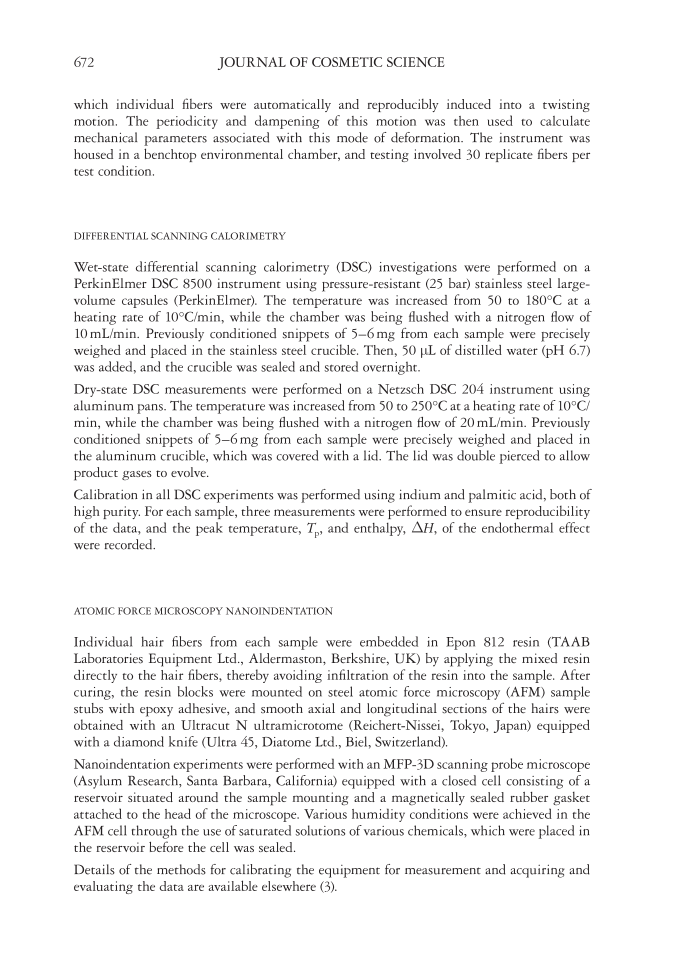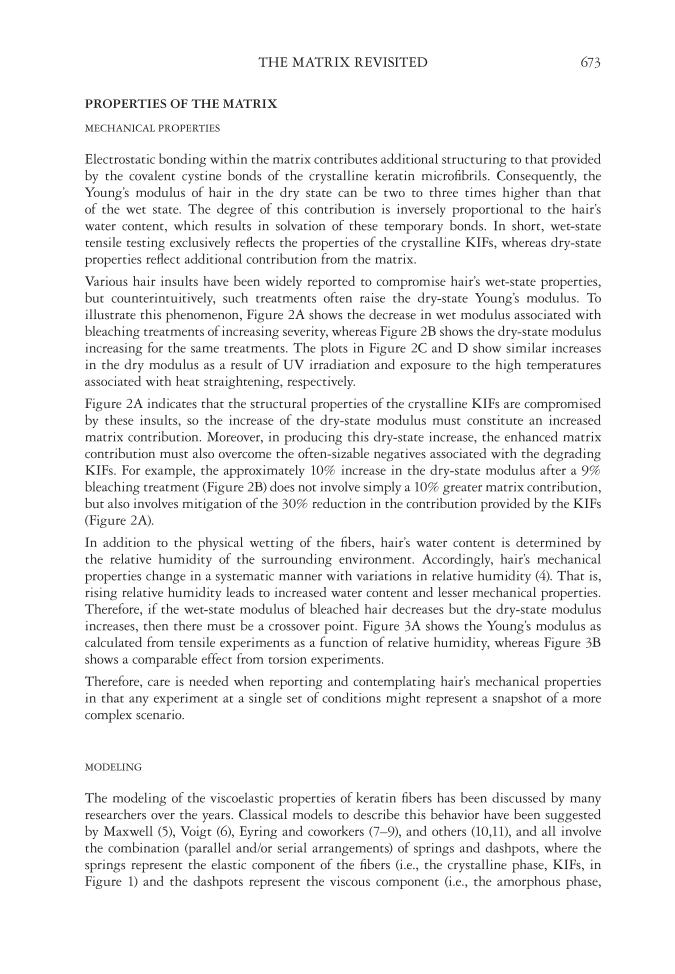672 JOURNAL OF COSMETIC SCIENCE which individual fibers were automatically and reproducibly induced into a twisting motion. The periodicity and dampening of this motion was then used to calculate mechanical parameters associated with this mode of deformation. The instrument was housed in a benchtop environmental chamber, and testing involved 30 replicate fibers per test condition. DIFFERENTIAL SCANNING CALORIMETRY Wet-state differential scanning calorimetry (DSC) investigations were performed on a PerkinElmer DSC 8500 instrument using pressure-resistant (25 bar) stainless steel large- volume capsules (PerkinElmer). The temperature was increased from 50 to 180°C at a heating rate of 10°C/min, while the chamber was being flushed with a nitrogen flow of 10 mL/min. Previously conditioned snippets of 5–6 mg from each sample were precisely weighed and placed in the stainless steel crucible. Then, 50 μL of distilled water (pH 6.7) was added, and the crucible was sealed and stored overnight. Dry-state DSC measurements were performed on a Netzsch DSC 204 instrument using aluminum pans. The temperature was increased from 50 to 250°C at a heating rate of 10°C/ min, while the chamber was being flushed with a nitrogen flow of 20 mL/min. Previously conditioned snippets of 5–6 mg from each sample were precisely weighed and placed in the aluminum crucible, which was covered with a lid. The lid was double pierced to allow product gases to evolve. Calibration in all DSC experiments was performed using indium and palmitic acid, both of high purity. For each sample, three measurements were performed to ensure reproducibility of the data, and the peak temperature, T p , and enthalpy, ΔH, of the endothermal effect were recorded. ATOMIC FORCE MICROSCOPY NANOINDENTATION Individual hair fibers from each sample were embedded in Epon 812 resin (TAAB Laboratories Equipment Ltd., Aldermaston, Berkshire, UK) by applying the mixed resin directly to the hair fibers, thereby avoiding infiltration of the resin into the sample. After curing, the resin blocks were mounted on steel atomic force microscopy (AFM) sample stubs with epoxy adhesive, and smooth axial and longitudinal sections of the hairs were obtained with an Ultracut N ultramicrotome (Reichert-Nissei, Tokyo, Japan) equipped with a diamond knife (Ultra 45, Diatome Ltd., Biel, Switzerland). Nanoindentation experiments were performed with an MFP-3D scanning probe microscope (Asylum Research, Santa Barbara, California) equipped with a closed cell consisting of a reservoir situated around the sample mounting and a magnetically sealed rubber gasket attached to the head of the microscope. Various humidity conditions were achieved in the AFM cell through the use of saturated solutions of various chemicals, which were placed in the reservoir before the cell was sealed. Details of the methods for calibrating the equipment for measurement and acquiring and evaluating the data are available elsewhere (3).
673 THE MATRIX REVISITED PROPERTIES OF THE MATRIX MECHANICAL PROPERTIES Electrostatic bonding within the matrix contributes additional structuring to that provided by the covalent cystine bonds of the crystalline keratin microfibrils. Consequently, the Young’s modulus of hair in the dry state can be two to three times higher than that of the wet state. The degree of this contribution is inversely proportional to the hair’s water content, which results in solvation of these temporary bonds. In short, wet-state tensile testing exclusively reflects the properties of the crystalline KIFs, whereas dry-state properties reflect additional contribution from the matrix. Various hair insults have been widely reported to compromise hair’s wet-state properties, but counterintuitively, such treatments often raise the dry-state Young’s modulus. To illustrate this phenomenon, Figure 2A shows the decrease in wet modulus associated with bleaching treatments of increasing severity, whereas Figure 2B shows the dry-state modulus increasing for the same treatments. The plots in Figure 2C and D show similar increases in the dry modulus as a result of UV irradiation and exposure to the high temperatures associated with heat straightening, respectively. Figure 2A indicates that the structural properties of the crystalline KIFs are compromised by these insults, so the increase of the dry-state modulus must constitute an increased matrix contribution. Moreover, in producing this dry-state increase, the enhanced matrix contribution must also overcome the often-sizable negatives associated with the degrading KIFs. For example, the approximately 10% increase in the dry-state modulus after a 9% bleaching treatment (Figure 2B) does not involve simply a 10% greater matrix contribution, but also involves mitigation of the 30% reduction in the contribution provided by the KIFs (Figure 2A). In addition to the physical wetting of the fibers, hair’s water content is determined by the relative humidity of the surrounding environment. Accordingly, hair’s mechanical properties change in a systematic manner with variations in relative humidity (4). That is, rising relative humidity leads to increased water content and lesser mechanical properties. Therefore, if the wet-state modulus of bleached hair decreases but the dry-state modulus increases, then there must be a crossover point. Figure 3A shows the Young’s modulus as calculated from tensile experiments as a function of relative humidity, whereas Figure 3B shows a comparable effect from torsion experiments. Therefore, care is needed when reporting and contemplating hair’s mechanical properties in that any experiment at a single set of conditions might represent a snapshot of a more complex scenario. MODELING The modeling of the viscoelastic properties of keratin fibers has been discussed by many researchers over the years. Classical models to describe this behavior have been suggested by Maxwell (5), Voigt (6), Eyring and coworkers (7–9), and others (10,11), and all involve the combination (parallel and/or serial arrangements) of springs and dashpots, where the springs represent the elastic component of the fibers (i.e., the crystalline phase, KIFs, in Figure 1) and the dashpots represent the viscous component (i.e., the amorphous phase,
Purchased for the exclusive use of nofirst nolast (unknown) From: SCC Media Library & Resource Center (library.scconline.org)






































































































































